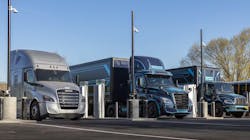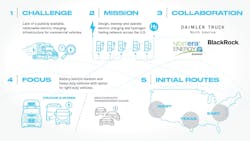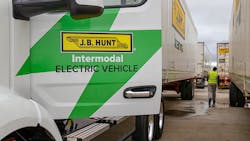Charging infrastructure holds back EV truck production, deployment
As decarbonization interests—and pressures—intensify within the trucking industry, it's becoming more apparent that creating the infrastructure needed to power the future heavy-duty vehicles that fuel the U.S. economy won't just take money. It is going to take time.
Trucking's current fueling network is so ingrained in the fabric of America that many might not recall what it took to create after the industry switched from gasoline to diesel as its primary fuel in the 1950s. "The truck stops started building out in the '70s," Craig Harper, chief sustainability officer at J.B. Hunt, said during Manifest 2023. "So they've had 50 years to develop this network of infrastructure that we all benefit from."
See also: EPA's new HD emissions rules push manufacturers and fleets to plan ahead
"We don't worry if we're going to be able to get fuel—we just worry if we're going to pay 2 or 3 cents too much per gallon," he said during a Feb. 1 panel on clean and efficient transportation systems. "How are we going to replicate that in the EV space in a short period of time? That's a real challenge because it takes a lot of power—and it takes a lot of real estate. That's among the drawbacks here."
John O'Leary, Daimler Truck North America president and CEO, said charging infrastructure is constraining deployments of Freightliner eCascadias, the OEM's Class 8 battery-electric truck that went into series production last year.
"We've had a lot of customers take delivery of an eCascadia or two and be super happy with what they have and immediately think they want to take 50 or 100. Then they realize that they don't have a way to charge," O'Leary said during a roundtable discussion with industry media on Jan. 31 in advance of DTNA's unveiling of its Freightliner SuperTruck II, its most efficient diesel-powered Class 8 truck.
True trucking decarbonization is years away
"Overwhelmingly, infrastructure is slowing us down in terms of EV deployment," he said. "Siting, permitting, and construction delays all mean current lead times are being measured in years—not weeks or months. There's a lot of will in the regulatory and political arenas to make that happen. But as we all know, when you start talking about moving large megawatt lines of electricity around, building new substations, and things like that, it takes time."
DTNA is leading a joint venture with NextEra Energy Resources and BlackRock Renewable Power to design, develop, install, and run a nationwide charging network for commercial battery-electric and hydrogen fuel-cell vehicles. O'Leary said the companies are hiring the leadership team for the venture, which he called "Project Juno."
See also: How to smooth the road to electric work trucks"We thought it was very important that we go out and get the best CEO, CFO, and executive team that we can find," O'Leary explained. "Install them in there and let them come up with a strategy rather than us, who know a lot about trucks but not so much about infrastructure and siting and things like that."
Having the charging and hydrogen infrastructure in place will help DTNA meet its corporate goal to convert to a fully carbon-neutral product line of its Freightliner and Western Star nameplates by 2039. But until that alternative fuel network is available to U.S. fleets, O'Leary said diesel will still be the primary power in trucking.
Along with DTNA, other North American OEMs have been rolling out heavy-duty battery-electric vehicles designed for regional hauls, such as Volvo Trucks’ VNR Electric, Peterbilt’s 579EV, and Kenworth’s T680EV. Volvo Truck North America’s Mack Trucks nameplate also has battery-electric refuse truck. Volvo has focused much of the past two years on building up its EV dealership and service network—which includes heavy-truck charging infrastructure available to any commercial vehicle—for its growing zero-emission offerings.
DTNA has delivered about 100 eCascadias in their first year of series production, according to O'Leary. "We could probably build 2,000 if it weren't for infrastructure issues," he said, noting that would still be a small percentage of the OEM's equipment output.
Along with the eCascadia, which is a Class 8 EV truck designed for regional haul, DTNA's Freightliner plans to unveil its electric M2 medium-duty truck later this year. But the OEM faces headwinds, according to Derek Rotz, DTNA's director of advanced engineering, who spoke with media in Las Vegas last week.
"It's not with the vehicle development, it's really with infrastructure and the time that it takes for that to build out," Rotz explained. "For that reason, we have to introduce things at the right time for the right reasons."
Time to experiment with future tech
J.B. Hunt's Harper said that fleets need time to experiment with EVs and other zero-emission products.
"What we're anxious to do is to test the vehicles as soon as we can and see how they're going to perform—and where the potential payback can be. Because all of these solutions have got to be commercially viable," he said during Manifest 2023. "You know, we can all have the greatest intentions and the best desires—but if the company is not sustainable in the long run, then we aren't going to do anyone any good."
Electrifying a fleet is challenging, noted Harper, who oversees sustainability efforts for a carrier ranked No. 5 on the FleetOwner 500: For-Hire. "It's tough to be green. We've ordered some electric trucks as far back as 2017 that we still don't have. We've got some other trucks that are beginning to be ready to come in, and we've actually taken delivery of a truck that we're still having difficulty getting charging set up."
Steve Hornyak, CCO at BrightDrop, a company focused on electrifying last-mile delivery, suggested fleets not wait for the perfect time to start electrification.
Speaking during a Jan. 31 Manifest panel on sustainability, he noted that many in the industry are worried about when the electrical grid can support EV fleet expansion. "There's all kinds of options out there for infrastructure," Hornyak said. "It doesn't have to be permanent. There's temporary, there's portable—and there's cost-effective ways to do it that actually can be done with CapEx or an evolutionary manner. So go now."
About the Author
Josh Fisher
Editor-in-Chief
Editor-in-Chief Josh Fisher has been with FleetOwner since 2017. He covers everything from modern fleet management to operational efficiency, artificial intelligence, autonomous trucking, alternative fuels and powertrains, regulations, and emerging transportation technology. Based in Maryland, he writes the Lane Shift Ahead column about the changing North American transportation landscape.



